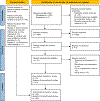Pediatric Tube Weaning: A Meta-Analysis of Factors Contributing to Success
- PMID: 36856955
- PMCID: PMC10989027
- DOI: 10.1007/s10880-023-09948-2
Pediatric Tube Weaning: A Meta-Analysis of Factors Contributing to Success
Abstract
Approximately 3-10% of children have severe feeding issues, and some require enteral/tube nutrition to grow and thrive. For many children, tube feeding is temporary, making efficacious interventions for tube weaning essential. We conducted a systematic review and meta-analysis of tube weaning treatments. Outcomes included percentage of participants completely weaned from the tube, and mean percentage of kilocalories consumed orally following treatment. Data were extracted from 42 studies, including cohort studies and single-subject research design studies. We evaluated moderators of treatment success, including treatment setting, use of behavioral approaches, use of hunger provocation, and use of a multidisciplinary approach. Results indicated that, after treatment, children received significantly more calories orally, and 67-69% of children were fully weaned. These analyses suggest that current interventions are generally effective; however, variability within treatments exist. Prospective randomized clinical trials are needed to understand effective components of weaning interventions.
Keywords: Meta-Analysis; Percent Weaned; Weaning from G and/or J tubes.
© 2023. The Author(s), under exclusive licence to Springer Science+Business Media, LLC, part of Springer Nature.
Conflict of interest statement
Declarations
Figures


References
-
- Babbitt RL, Shore BA, Smith M, Williams KE, & Coe DA (2001). Stimulus fading in the treatment of adipsia. Behavioral Interventions: Theory & Practice in Residential & Community-Based Clinical Programs, 16(3), 197–207.
-
- Bachmeyer MH, Gulotta CS, & Piazza CC (2013). Liquid to baby food fading in the treatment of food refusal. Behavioral Interventions, 28(4), 281–298.
-
- Berlin KS, Davies WH, Lobato DJ, & Silverman AH (2009). A biopsychosocial model of normative and problematic pediatric feeding. Children’s Health Care, 38(4), 263–282.
-
- Berlin KS, Lobato DJ, Pinkos B, Cerezo CS, & LeLeiko NS (2011). Patterns of medical and developmental comorbidities among children presenting with feeding problems: A latent class analysis. Journal of Developmental & Behavioral Pediatrics, 32(1), 41–47. - PubMed
Publication types
MeSH terms
Grants and funding
LinkOut - more resources
Full Text Sources
